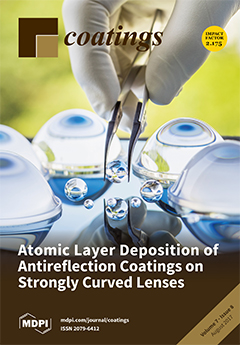Studies have shown that perovskites have a high potential of outdoing silicon based solar cells in terms of solar energy conversion, but their rate of degradation is also high. This study reports on improvement on the stability of CH
3NH
3PbI
3 by passivating it with polymethylmethacrylate (PMMA). Structural and electronic properties of CH
3NH
3PbI
3 stabilized by polymethylmethacrylate (PMMA) were investigated by varying concentrations of PMMA in the polymer solutions. Stability tests were performed over a period of time using modulated surface photovoltage (SPV) spectroscopy, X-ray diffraction (XRD), and photoluminescence (PL) measurements. The XRD patterns confirm the tetragonal structure of the deposited CH
3NH
3PbI
3 for every concentration of PMMA. Furthermore, CH
3NH
3PbI
3 coated with 40 mg/mL of PMMA did not show any impurity phase even after storage in air for 43 days. The Tauc gap (
ETauc) determined on the basis of the in-phase SPV spectra was found in the range from 1.585 to 1.62 eV for the samples stored during initial days, but shifted towards lower energies as the storage time increased. This can be proposed to be due to different chemical reactions between CH
3NH
3PbI
3/PMMA interfaces and air. PL intensity increased with increasing concentration of PMMA except for the perovskite coated with 40 mg/mL of PMMA. PL quenching in the perovskite coated with 40 mg/mL of PMMA can be interpreted as fast electron transfer towards the substrate in the sample. This study shows that, with an optimum concentration of PMMA coating on CH
3NH
3PbI
3, the lifetime and hence stability on electrical and structural behavior of CH
3NH
3PbI
3 is improved.
Full article





